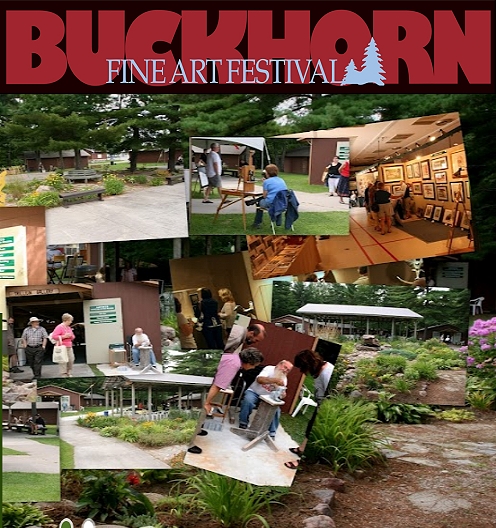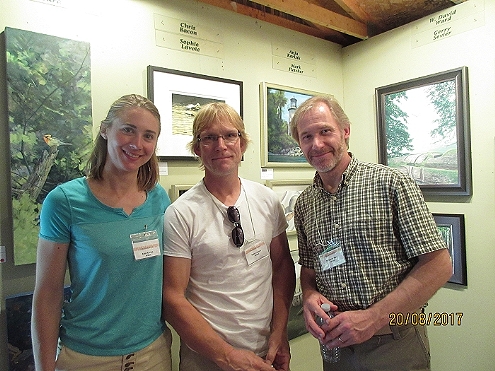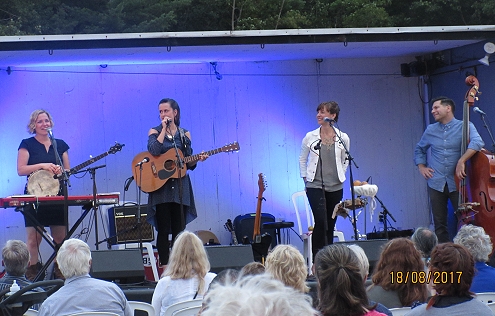
The 40th Buckhorn Fine Art Festival is fast approaching, and this year's year's exhibition will feature a Regionalism booth, where the work of sixteen artists will be on display. Please visit the BFAF website, or click on the image below, for more information. We look forward to seeing you there. |
 |
 |
Artists, Anja Karisik, Gary Landon and W. David Ward, at the Buckhorn Fine Art Festival's 'New Regionalism' booth (complete list of artists below) |
 |
| The Good Lovelies on stage |
Participating Artists
Andrew Cheddie Sookrah - Angela Lorenzen - Anja Karisik - April White - Brent Trach - Billy-Jack Milligan - Chris Bacon - Ciba Karisik - Gary Landon - George Raab - Gerry Sevier - John Ovcacik - John Stuart Pryce - Mark Fletcher - Michael Dumas - Sophie Lavoie - Tim Hough - W. David Ward - Wayne Mondok |
Regionalism Today
A new Regionalism in art has emerged. Born of the nature and wildlife art movements of the 80s and 90s – and deeply rooted in the Romantic tradition – this movement carries forward the essential values of an earlier, more enlightened age. Regional art movements appear every few generations, in response to the times. The Romantic painters are widely regarded as the first Regionalists, in England and the United States, where they spoke out against the social, economic and environmental impact of the Industrial Revolution. A uniquely American Regionalism sprung up in the 1920s and ’30s, in the wake of rapid Industrialization on this continent; while here in Canada, in the 1960s and ’70s, London Regionalism – a fiercely independent, proudly Canadian, activist art movement – resisted the cultural and economic influence of our powerful neighbour to the south. In England, the Romantic painters promoted Working Men’s clubs, continuing education and social security; they are credited for inspiring Britain’s social safety net, and the notion of a social contract. They promoted an awareness of the environment, and later members of the Hudson River School, in the United States,were instrumental in establishing the park system; most notably, Yellowstone and The Grand Canyon. Moran Point, on the South rim of the canyon, is named after artist Thomas Moran. The painters of American Regionalism, in their turn, had a ‘profound impact’ on the shaping of the New Deal, but it was rather more difficult for the London Regionalists to effect such change, as Postmodernism had been at work for some time, ‘turning active citizens into passive consumers’, as Eleanor Heartney states (and others echo) referring to influential works such as Frederic Jameson’s ‘Postmodernism and Consumer society’. Their warnings, and calls to action, went unheeded therefore. Undaunted, independent artists continue to be engaged with real world issues; they buck the trends and fight to keep a valuable tradition alive. The goal of the Regional artist therefore, is to counter the influence of postmodern ideas. Realism is the expression of choice for these artists; ‘perspective’, ‘perception’ and an objective point of view. The central values of the ‘Romantic’ movement of the Nineteenth Century – beauty, nature and truth – are conveyed most effectively through representational forms, and these timeless values inform regional painters of our day, as they did then. As regular as clockwork, on the heels of a revolution in digital technology this time, Regionalism responds to a new set of issues. Among these – fittingly, in Canada’s sesquicentennial year – sovereignty and national self-determination; in an era of globalization, national is the new regional. An awareness of the environment – and the understanding that our health and well-being is inextricably linked to that of the natural world – can be preserved only so long as we maintain a connection to nature. In an increasingly urban, technology-based society, the role of the nature artist has never been so important: to foster concern for, and understanding of, the natural world – particularly among younger generations. Away from the glitter, glamour, and trends of the big city ‘art scene’, Regionalists have not been distracted. They have maintained their focus and still speak to issues of importance; for the society in which they work and the world in which we all live. Independent artists today are the eyes of society; theirs is an art for the people. |